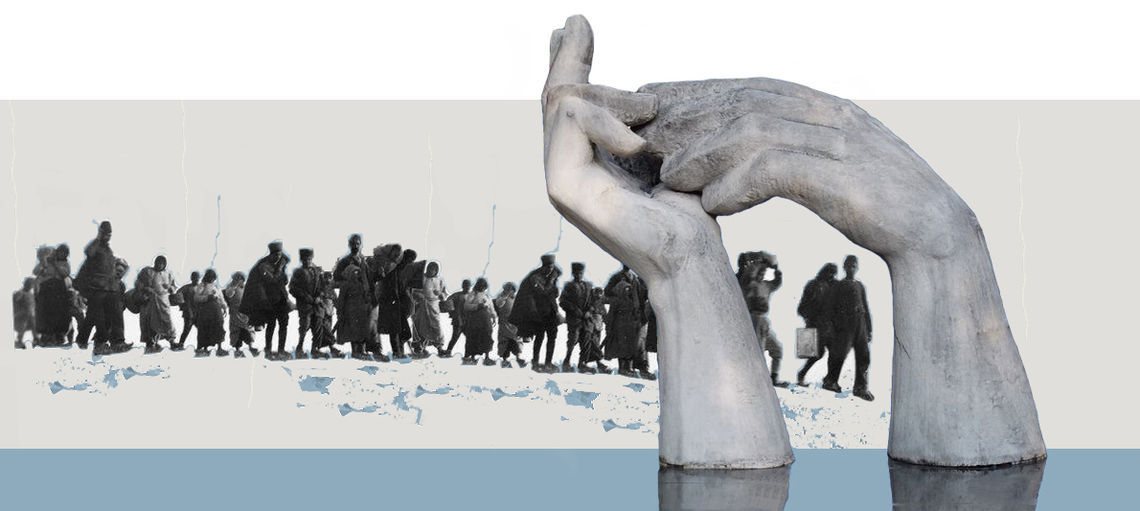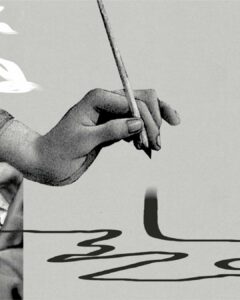
The debate on “Armenian identity” has a long history and is an ever-evolving discourse, especially in the Diaspora. In the last 100 years since 1915, along with efforts to build communities in dispersion, there have been hierarchies of identity and canonical approaches to definitions of “Armenian,” especially as articulated, rationalized and promoted by elites, institutions and political parties in the Diaspora and in Armenia.[1] This essay is not a study of identity per se, but about one of the aspects of identity – the “Armenian” bit of it.
Definitions of ethnicity encompass “all ascriptively-based group boundaries, including based upon race, religion, language, and/or region.” Generally, scholars argue that “characteristics such as religion, language and region are viewed as ascriptive rather than cultural because they are typically defined for purposes of ethnicity,” which refer to ethnic lineage and ancestral customs rather than current practices or locality of a person or a group. Therefore, “while individuals may adopt new languages, lapse or change religions, or alter their places of residence, it is much more difficult for them to change their ethnicity, even when ethnicity is based upon such characteristics.”[2]
Contemporary scholarship and theories of ethnicity have shown that “ethnic boundaries” — patterns of social interaction that reinforce self-identification of a group and outsiders’ confirmation of the group’s distinctions — are socially constructed. They are “not predetermined by biology or customs, but malleable and responsive to changes in the surrounding social environment.”[3] As such, ethnic boundaries are social mediums through which members associate with the larger group. Culture and geography are the two most emphasized elements in most of the literature on ethnic identity research. The cultural element is generally “viewed as a social construction involving insiders and outsiders mutually acknowledging group differences in cultural beliefs and practices.” The other is employed to define the geographic origin of ethnic groups and, as such, “social origins that are foreign to the host society.” The geographic element has a largely objective basis, but is also partly subjective.[4]
In the Armenian case particularly, on one hand, there are a host of assumptions on identity and “politically correct” definitions, expectations and interpretations of “who is an Armenian.” On the other, new self-defined and actualized “Armenian identities” are prevalent among post-genocide third and fourth generation Armenians spread around the world. These include, for example, not only hyphenated Armenians (American-Armenian, Lebanese-Armenian, Russian-Armenian, etc.), but also percentile-Armenians (half, quarter, 1/8 Armenian, etc.) and, recently, the more openly discussed category of “Islamized Armenian” identity.
Identity is not a fixed notion; it is an evolving concept depending on the social, political, and cultural environment, among other aspects, in which Armenians find themselves.
In short, identity is not a fixed notion; it is an evolving concept depending on the social, political, and cultural environment, among other aspects, in which Armenians find themselves. The case of the Armenian communities in the Middle East provides a glimpse of the fact that identity construction, preservation and extension are not only a matter of internal group self-definition, externalization and internalization. In the Middle East, identity is also imposed from a variety of sources that include state and social structures, political processes and religious-cultural conditions. On one hand, identity markers for both the majority host society and the minority communities are state-defined, socially constructed and objectified. On the other, what might be termed the ‘soft othering’ of Christians and other non-Muslim groups by state and religious discourse reinforces the ‘differences’ and ‘incompatibilities’ of the ‘others’ in the mind of the larger society.
Generally Arab states impose, for instance, a national curriculum on Armenian or minority schools and draw socio-political (and legal) boundaries around non-Muslim communities. The state grants citizenship and a passport to an ethnic or religious ‘other’, yet limits or bans careers in high level civil service for minorities. The imposition of ethnic-religious identity is also systemic, overriding individual choice. For example, should an Armenian person declare him/herself to be an atheist or is not a member of any church — and does not speak the language — in legal records that person would still be classified or labelled by the State and its institutions as an ‘Armenian Christian.’ As a member of a non-Muslim group, there is virtually no choice except to be identified by one’s ‘birth group’ or ethno-religious affiliation. In other words, the person always remains as the ‘other’ vis-à-vis the dominant ethno-religious group, with its attendant implications.
In the 21st century, Armenian identity is a matter of choice for the vast majority of the third and fourth post-genocide generation of Armenians in the Diaspora, who participate in community life voluntarily rather than as a matter of obligation.
There are intergroup influences on identity construction as well. Referring to the post-genocide first generation Armenians growing up in the Middle East, Yervant Pamboukian, a leading intellectual, teacher and former editor of Aztag newspaper in Beirut, said: “We lived our childhood in a period when we constantly heard about the sufferings and persecution” that his parents’ generation had been subjected to. “A great weight was put on us, to secure the rebirth of the nation. It gave us strength as the nation was going to be reconstructed by the children of the survivors of the Genocide, the generation of those whose lives were worn out in the orphanages.”[5]
In the 21st century, the perceptual and functional understanding of identity is changing, especially for an ever mobile and globalized Armenian Diaspora. Here, it is important to make a conceptual distinction between “Armenian identity” — the ascriptive aspect described above — and “Armenianness” — the cultural aspect — which at times are used interchangeably. One could compare Armenian identity to an “ethnic passport,” which one possesses to be identified with a group or a country; it is granted, acquired or self-claimed. However, Armenianness is what one does with that ethnic passport, how far and deep one travels into the “Armenian world” or into a world made of “things Armenian” — that is, the process by which one finds venues, opportunities, causes or reasons to actualize the wishes, desires, feelings, and thinking that are driven by one’s sense of identity. Put in another way, identity is the structure (the hardware), Armenianness is the agency (the software). While all Armenians who are or claim to be Armenians are fully Armenian, some Armenians choose to “travel” or explore more than others into the “Armenian world.” As such, Armenian identity “cannot be described exhaustively” and “in its totality,” like Foucault’s concept of “archive of a society, a culture, or a civilization,” — that is, the systems of enunciability, functioning, formation and transformation of events or things.[6]
The distinctions between various types of Armenianness are not absolute, for instance, between traditional and symbolic Armenianness, as Anny Bakalian, in her seminal study of Armenian Americans, suggests.[7] However, there are differences in perceptions, emphasis and expectations. The traditionalists advocate that speaking Armenian and being immersed in ethnic subculture are essential preconditions of “being Armenian.” Conventionally, the Church, political parties, voluntary associations and other collective structures have defined the structural parameters of Armenian identity and have advocated an essentialist form of collective expressions of Armenianness.[8] In this thinking, Armenian identity is an ascribed status, that is, if one is born of Armenian parentage or has “Armenian blood,” they are automatically considered a member of the larger Armenian nation. In this traditional perception of identity, the idea of choice is not taken into consideration — an aspect of modern life so prevalent among and significant for the newer generations of Armenians.
Between the traditional and symbolic views, there are yet other perceptual varieties which define Armenianness through a set of qualities rather than just origin. A good example of this is the “definition” that Peter Balakian’s mother provides, when he describes the type of woman she expected him to go out with. “A woman had to qualify by being jarbig, which meant she had to have energy, wit, vitality. She had to be achgapatz, open-eyed, so that nothing could get past her, for she was keeper of the gate, the protector of things sacred: family and husband. If a woman wasn’t jarbig and achgapatz – clearly my mother thought she possessed these qualities in abundance – she wasn’t worthy, she wasn’t in the existential sense, ‘Armenian’.”[9]
In the 21st century, Armenian identity is a matter of choice for the vast majority of the third and fourth post-genocide generation of Armenians in the Diaspora, who participate in community life voluntarily rather than as a matter of obligation.[10] This choice is expressed through a sense of pride in one’s heritage, feelings toward people and things Armenian, and involvement with other Armenians. For the new generations, as Bakalian explains, Armenianness is “voluntary, conscious, rationalistic, segmental, transitory, sporadic, that is, symbolic. Sentiment and convenience become the modus vivendi for maintenance of almost all aspects of Armenianness. Feelings run high, but when it comes to behavioural participation, convenience is the key.”[11] Symbolic Armenianness is more to do with emotions than genetic origins. Seen in its positive dimension, it provides valuable psychological function in today’s increasingly individualistic and highly mechanised world. It provides a sense of rootedness and belonging. Indeed, practicing one’s Armenianness is not dependent only on participation in traditional community life, but there are myriad of other choices in today’s ultra-connected world where symbolic ethnicity could be lived or experienced.
In sharp contrast, the 21st century is increasingly becoming a “world of self-reference” — that is, a world where trust in organizations, institutions or governments are increasingly declining and one’s own position and beliefs are considered more relevant than other sources. Top-down traditional influence on discourse and identity is in a process of reversal and is becoming more horizontal than vertical.
To answer this question, one could look into the various domains of culture: literature, music, architecture and visual arts to see what it is in these cultural traits or domains that make them “Armenian.”
In this short essay, I shall take only one area and provide a sociological reading of Armenian folk music as observed and analyzed by Komitas (Father Komitas Soghomonian, 1869-1936), a priest in the Armenian Church, who was an ethno-musicologist, singer, choir director, music teacher and composer. Komitas spent years in villages and towns collecting Armenian songs and dance music and attempted to penetrate into the depth of this significant cultural domain. I chose to focus on folk music because this genre is most relevant to the problematics of cultural production and identity in the Diaspora.
Komitas explains that, in general, Armenian folk music could be divided into two branches: Eastern and Western Armenia. “Western melodies are broad and complex, rich and serious, bright and brisk; Eastern melodies are compact and simple, unsophisticated and light, prosaic and peaceful.”[18] Indeed, one could make similar observations on other cultural aspects of East and West.
Today music listened to (or used) during social gatherings or “clubbing” is not expressions of daily life, or community rituals, but reproduced and reshaped, mixed and matched to consumer needs and expectations.
In the 21st century, what is “Armenian” in Armenian identity is what you think Armenian is — as such, one could say the process has moved from feeling to thinking Armenian.
In conclusion, even as it is impossible to describe exhaustively and in its totality what “Armenian” is in Armenian identity, I suggest, it is the connections, the relationships, the occasions in diasporic life in the 21st century that makes a piece of music or a painting, or literature or a bowl of harissa “Armenian.” It is the memory, thought and message that a cultural object or creation represents that makes it “Armenian” by connecting it to a meaning system that is larger than an individual’s personal world.

